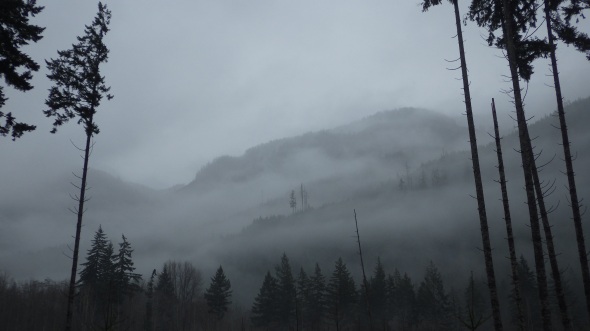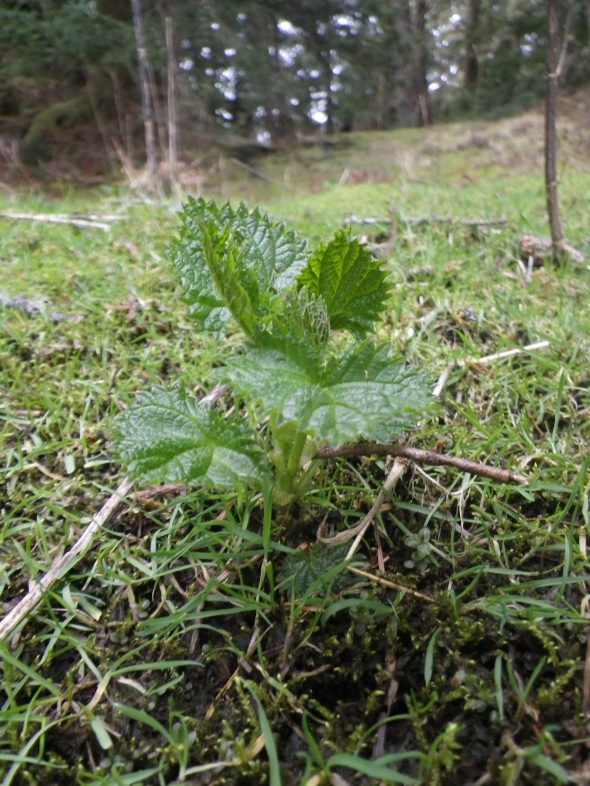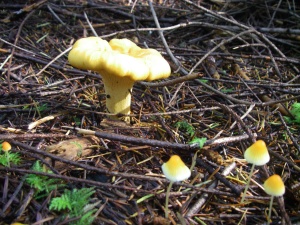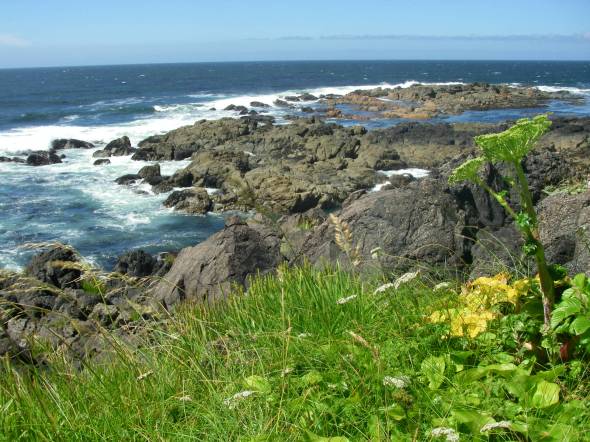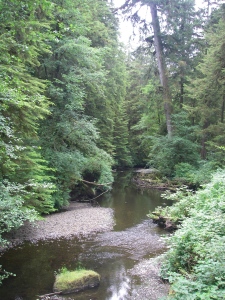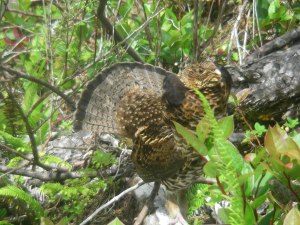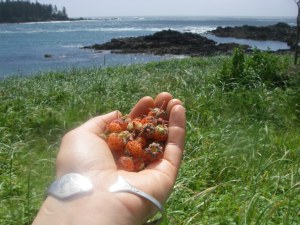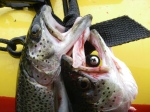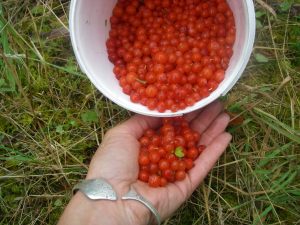Latest
Reflections from a Beachcomber
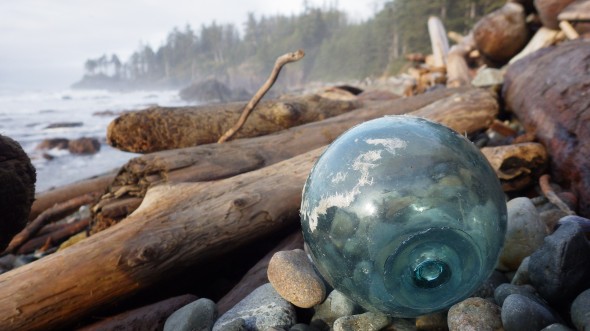
From Japan
When thinking about nutrition and foremost nourishment, sustenance and food may come to mind but the obscure, like things we know and can’t explain go denied. Food feeds our body but spiritual nourishment from the land and ocean, the rivers and animals and the things we believe but cannot measure are in my opinion equally important.
We are a population of consumers, making money to feed, cloth and shelter ourselves and too tired to care or notice that our consuming is taking a toll on the environment, worldwide.We buy things we don’t really want, we fall prey to societies pressures, expecting it all. And we get it all, all at a hefty price. Our collective thinking, our culture is dying of malnutrition. We are starved of nature and we are starved by the multinational food industry.
Simultaneously, a shitload of garbage washes up on our western shores of Vancouver Island and another forest of old growth cedar is sheared to stumps and a Chinese factory worker across the Pacific Ocean buries her anger while she sews our clothes, and the mother next door feeds her children pesticide sprayed produce and we grow quantities of food, not quality of food and fish tons and tons of fish from the ocean to feed all the tons of people in the world that are going through societies conveyor belt of enculturation.. ….WOW…(can’t believe I said this, in one gulp!!!)
And here on Northern Vancouver Island in the month of June a wolf pup playing on a riverbank cowers and runs from the growing whine of a chainsaw and the earth quaking boom of falling timber, tumbles along the worn wolf path to safety and finds its home a clear cut. ….
Preferably unnoticed….it goes on, and we are each partly to blame for it, we each take our piece from the earth…. Of course, all of us consume differing amount of resource, but the big question can our resources hold up to our collective desires and want of prestige?
Amongst the pile of garbage there still remains goodness and beauty. A lot of it.
One needs to notice it, keep searching for it, keep fighting for it, expect beauty not drudgery, so we can keep the hope alive.
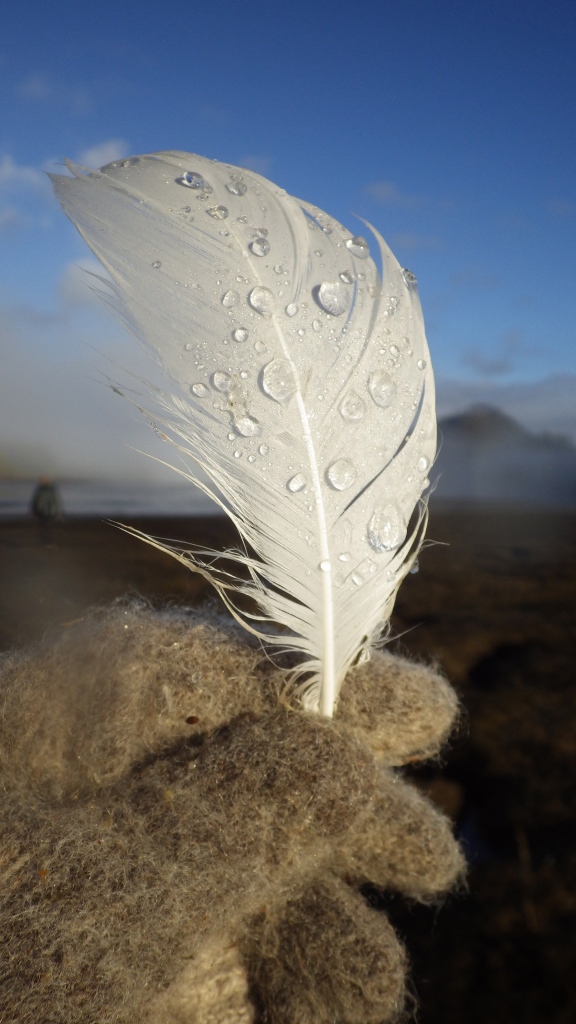
On a cold day in the quiet of winter the morning breeze is lifting the fog away and revealing a west coast lagoon full of ducks, geese and swans. A swan feather with frozen droplets of water.

There is no end to the plastic and non plastic garbage on the west coast beaches. I think we want to identify all this garbage to the tsumani and yes it is arriving but there was tons of asian (and local garbage) before this event. Every year it seems the storms push the same garbage from beach to beach and new garbage adds to it. Some of it is so fresh and new as if a foreign ship is only beyond sight over the horizon.
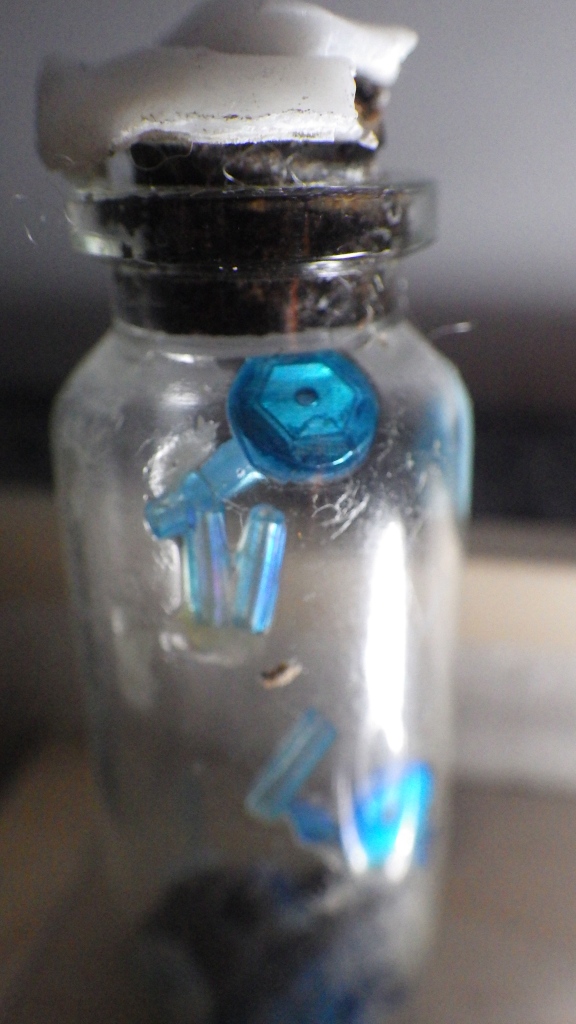
A very cute…Message in a Bottle…2 inches tall….washed up on the tide line…..as yet no reply from sender…a tiny note rolled and twisted with wire…. humorous…The sender referred to being a high sea sailor, getting low on rum…and concerned about it !!
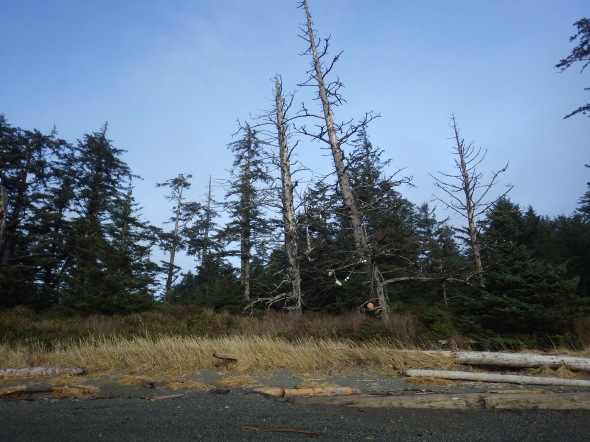
Winter: There is something mysterious about the forest that fringe a west coast beach……this photo is missing the caw of the trickster….a raven!
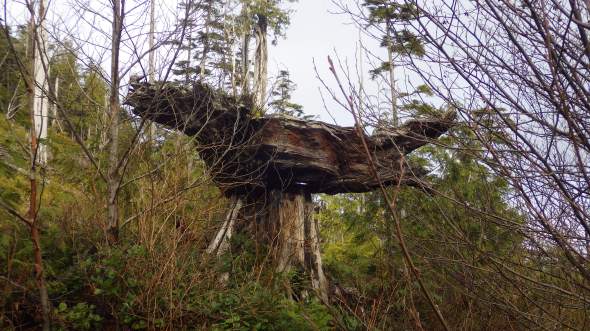
Artistry in the clearcut….surprised to find a seal overlooking the ocean!

…………..Mysterious morning fog in a clearcut on the west coast.
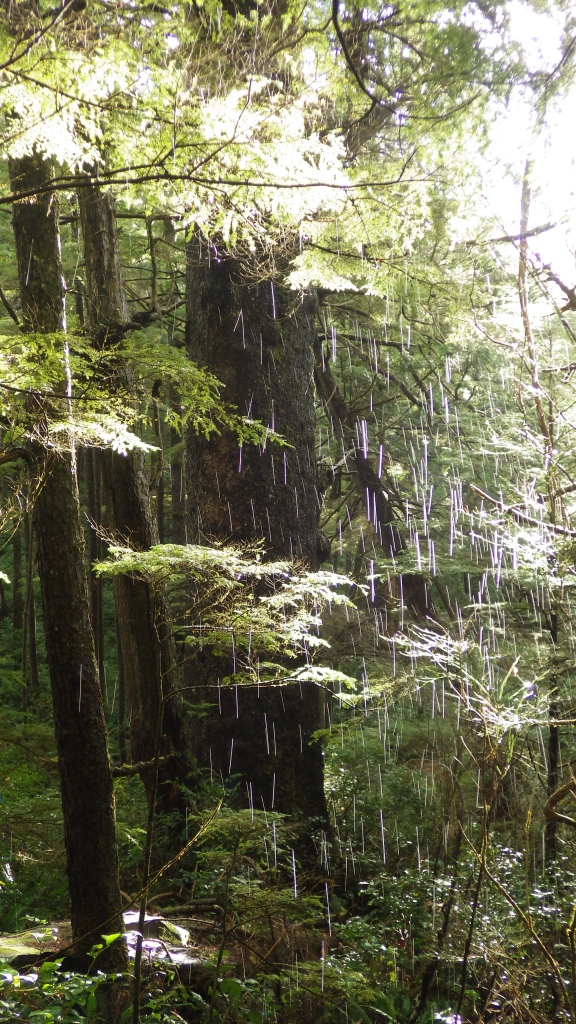
A west coast forest between clearcut and pounding surf on West Coast Vancouver island. What last remains of some wild, is here in this forest. And it was flagged to be cut…..Hope you can get outside and explore, be aware …..
…..Scenery and days like this you will never forget.
Giant Seaweed meets the Kitchen (updated)
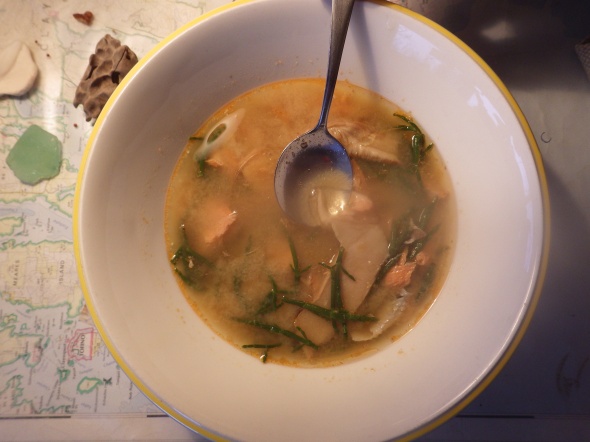
- Sea Soup….think seaweed and salmon and sea asparagus and chanterelle mushrooms and pine mushrooms simmered in a slow cooker all day, or better yet over the fire on a west coast beach! Unfortunately I haven’t been able to find all ingredients at precisely the same time … So it all needs to be caught and gathered and processed for later use.
The ocean offers everything, even a Japanese glass float after the storm.
Giant Kelp or Macrocystis is a brown, canopy growing seaweed that can reach lengths of 100 feet. The blades are wrinkled and each blade has a gas filled bladder attached to the main stalk. Interesting to note about seaweed is that there are three main groups: green, red, and brown and each group grow at differing water depths.
Tolerance to stress such as wave action, substrate attachment, and exposure to air is indicated with different seaweed groups growing in a vertical striation along the shore. The line of growth of red, green, and brown kelp is most noticeable on an extremely lower, low tide meaning the time when the tidal range is at its extreme lowest. In addition this mosaic of color is most noticeable on bedrock beaches because the seaweed holdfasts have a solid substrate to grow on.
Giant Kelp or Macrocystis is distributed in the lower intertidal and the Subtidal zone, the zone below the extreme lower, low, water and the Subtidal, the area below the lowest intertidal and the area exposed to little or no air (Lindeberg&Linstrom, 2010). It is distributed from Alaska to Mexico. There is two different species indicated by their holdfast. As you can envision the deep water (lower subtidal) growing species, Macrocystis pyrifera needs more arms to hold to substrate in deep, ocean wave habitat. Often after a storm their hand size holdfast can be found washed up on the shore, a brown-red clump, a mass of interwoven threads.
Macrocystis pyrifera is distributed from Monterey to Mexico, but it is known to grow in certain areas of B.C and Alaska. The species Macrocystis integrifolia inhabits the northern region where it grows in the lower intertidal and upper subtidal (Druehl, 2007).
Macrocystis is “the largest of all seaweeds” (Druehl, 2007. Pg.93) and when dried and finely ground and cooked alone or with other food, is a great addition to every meal.
Note: Another brown seaweed much easier to collect especially on your walk along the shore at low tide is the brown seaweed, Rockweed or pop weed, Fucus distichus.
Remember: Brown seaweeds need to be cooked. Sprinkle food with brown seaweed flakes before popping in the oven. Or cook separately-Seaweed and water-boil and simmer, make a paste and use as a topping.
References:
Druehl, L. 2007. Pacific Seaweeds, A guide to common seaweeds of the West Coast. Harbour Publishing. B.C.
Lindberg,M .& Lindstrom,S. 2010. Field Guide to Seaweeds of Alaska. Published by Alaska Sea Grant Program, University of Alaska. Fairbanks.

Here is an interesting example of a seaweed holdfast clinging to a scallop shell though not sure what type of seaweed it belongs to.
Here is another type of seaweed called sugar kelp, a very thin bladed kelp easy to break up when dry, unlike the Giant kelp which is tough and leathery. Here it is drying on a summer day in the boat.

more…… seaweed drying…..
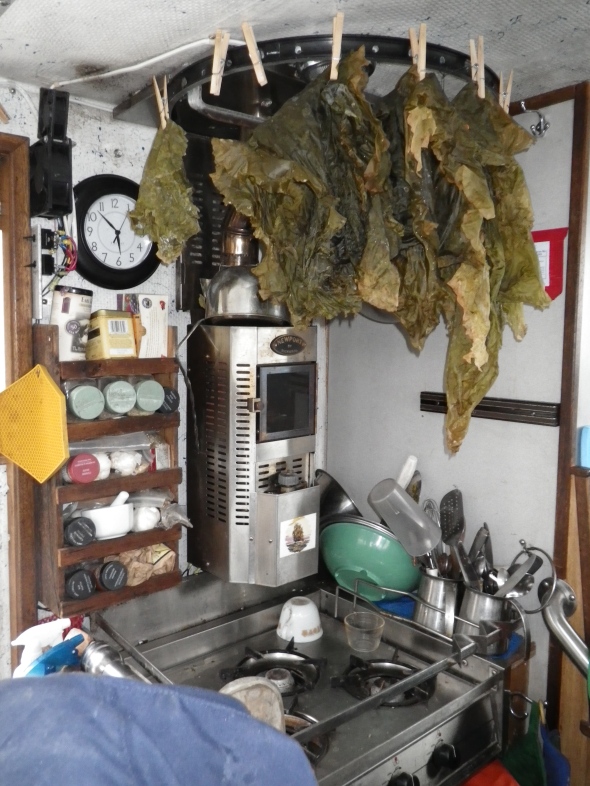
A brown seaweed ; Sugar Kelp drying.

Macrocystis dries to a very tough leather, so it needs to be ground up to be palatable. A cuisinart spice and nut grinder works well to blend it into fine flakes.
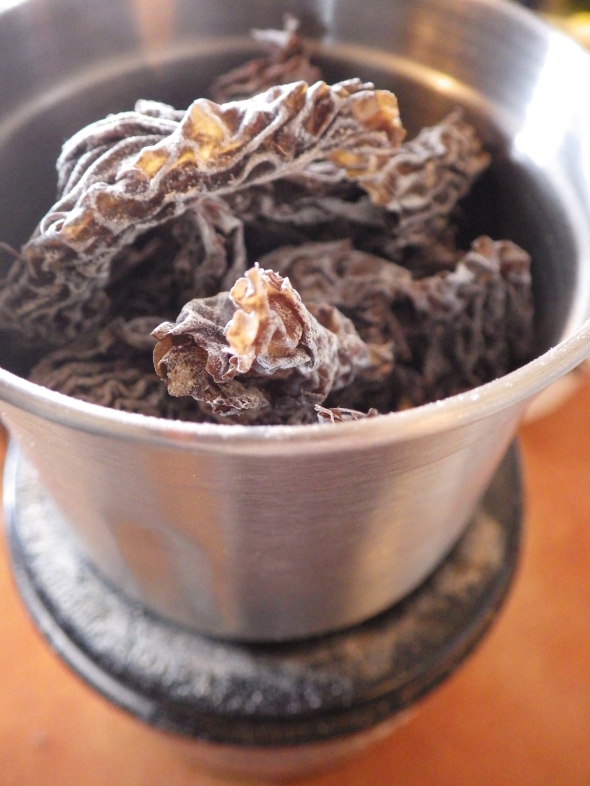
Macrocystis ready to grind up in the blender. For larger pieces simply break up with your hands or for tougher pieces you may need to use scissors.
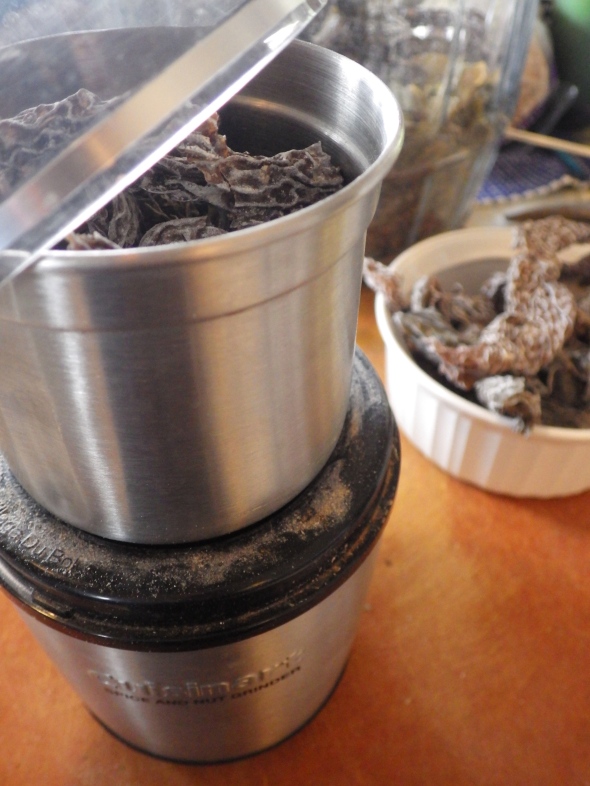
Another blender load of seaweed ready to go…

To benefit nutritionally from the brown Seaweed flakes it is advised to cook to release the beneficial fucoidans noted in brown seaweed ( the sugars need to be broken down to utilize). I like to keep flaked seaweed on hand in a sealed jar or better yet a red pepper shaker that has big holes for seaweed flakes. Sprinkle and cook with salmon, rice or vegetables.
In the science world there is interesting research being done on the nutritional benefits of brown seaweed. I am not an expert on seaweed. As with all the abundant wild food in my surroundings I am always learning something new as I research it, learn its habitat from season to season and become perceptive in the nuance changes of the environment. Without the last remaining wild we loose a food source, a mystery, and a curiosity toward the natural world. As with any food, it is advisable not to over consume seaweed, only incorporate it into the diet. And on this parting note it is up to you what you eat and how you feel eating it and you may find after doing your own research seaweed may be a food for you.
Give Seaweed a try in the kitchen, any seaweed, you’ll be pleasantly surprised by this tasty, nutritious addition to your diet!
Raw Food Diet ??

Salmon
What does food harvested from the wild and the raw food diet have in common? I don’t know if I can answer this question but a quick ponder makes me think they are at opposite polarities in how one consumes food.
Recently I’ve become responsive to the benefits of a raw food diet and have started incorporating raw food into my existence. To a certain degree it makes sense though I could never eliminate a whole horde of food and completely embrace the raw food or vegan diet. But being responsive to the raw food diet has led me to believe in a few of the following beneficial aspects: eating fermented foods, avoiding overcooking vegetables and presoaking beans and nuts.
Fermenting: fermented foods help increase the good bacteria in the intestine and are beneficial for outnumbering the bad bacteria. Eating fermented food help break down protein i.e.) sauerkraut-unpasterized with salmon or steak.
Overcooking Vegetables: It is advised not to cook vegetables over 115 F. because are killed enzymes. Dehydrating is the method of “cooking”, so the common oven goes out the window! (Not this extreme yet!)
Soaking Beans and Nuts: This turns off the enzyme inhibitor therefore allowing the protein to be ingested into the intestine. Soak nuts and beans for their recommended time then rehydrate the nuts. Or for making a refreshing drink full of good bacteria and enzymes make a drink called Rejuvec-soak for example rye grain or quinoa-let it sprout then refresh water and let it grow until it bubbles and turns cloudy (1-2 days). The drain off is a refreshing lemony drink.
Upon further thinking maybe this type of diet does overlap in ways with the diet that is harvested from the wild. It is healthy unprocessed food. And concerning growing or fermenting food with wild food, my mind reaches toward the cupboard to the jar of eulachon oil. Now that’s some strong smelling oil!
Now back to the idea of being receptive and where this topic began.
I find the journey in life is full of roads waiting to be explored especially when you’re receptive to what life has to offer, and judgment is kept at bay. Sometimes difficult,
but in this case an open mind, opened the gate to some new additions in my diet, and a few like Rejuvenac and fermentation and knowledge on soaking nuts will be permanent.
The following is some evidence that the raw food diet and the wild food diet can be combined to create an extraordinary new archaic diet!!?……
Here are a few recipes:
Power Cookies:
1 cup dates
¼-1/2 cup coconut butter or oil
1 cup almonds –soaked overnight
¼ cup cocoa powder
½ cup chia seeds (soaked for 2hours)
½ cup flax seeds (soaked for 2 hours)
1 cup raisins
1 cup coconut flakes
Blend all ingredients well….roll in coconut flakes. Place on coconut oiled sheet. Keep in refrigerator.

Power cookies
Alive Cheese:
2 cups almonds (soaked overnight) then places in warm water to remove skins
1 cup rejuvenac water (soak 3 cp rye wheat until sprouted tails-then add 2-3cps fresh water and let grow until bubbly and water turns cloudy).
2 teaspoons lemon juice
chopped fine fresh marjoram ,thyme, basil
1 tablesoon miso
sea salt
Blend almonds and Rejuvenac. Place in bowl, cover in warm place and let grow in size for 1-2 days. Drain excess liquid using cheesecloth. Add lemon juice and miso. Mix. Roll into cylinder form with parchment paper. Sprinkle herbs on the parchment paper and continue forming. Let sit for a day or eat immediately. Eat with pear slices. Delicious.
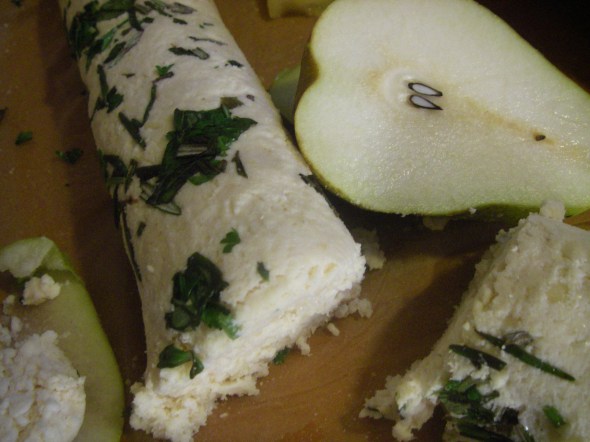
Alive Almond cheese
Enjoy your adventures in the realm of the kitchen!
Rain+Rain=Chanterelles
Rain + Rain and More Rain= Chanterelles.
Although chanterelles need plenty of moisture to emerge, they can easily succumb to moisture overload and become too waterlogged for quality processing.
Yesterday weather conditions: cloudy, overcast and a day, like no other day of autumn, and a day, like no other day of the year or no other day of my life!
The chanterelles were out like I have never seen before. Bunyan sized chanterelles with flowery edges and natural hydraulic force pushed through the forest floor. The forest, mossy and green with salal and Oregon grape and second growth fir was alive with gardens of orange and white chanterelles.
And if I was ever more alive it was yesterday, and if I was ever more tired it was yesterday.
I picked crazy. I shouted in ecstacy. A raven replied to me. The creek carried on a streaming conversation.
The forest lay still, all seemed dead still. If only I could hear it, if only I could see the invisible, if only I could understand and speak the language: the alive forest, imperceptively changing and growing and talking as I stood within it. Mushrooms underground were pushing up, pushing me skyward, increasing my height, making me queen of the chanterelles for the day.
The basket filled up. Heavy. I carried it away to empty. Then in no time another basket full. Heavy.
The forest darkened and I had no idea where time had gone. What is time? A question to ponder for a day spent in a world that is cloaked in mystery. And another question to ponder? How can we ever understand the forest when we can’t understand the language of the raven, or the stream, or the chanterelles gasping to the surface.
I walk through the darkening forest, through grey and greenness and air so thick with good health…. until I pass through an invisible wall to another world.
Now I must leave the world of chanterelles and the questions behind, sort of, in order to live in the other.
I have just lived one of the best days of my life.

A great chanterelle !
All day nice large chanterelles were found…….one in a basket full !

A patch of chanterelles
One of many patches…every few steps more and more……

White Chanterelles
These white ones were all over the place too !!

Surplus drying
Surplus chanterelles that don’t fit in the dehydrator go to racks next to the wood stove. The more saturated the mushroom, for example picked after heavy rains, the quicker they will turn brown and mold when kept this way too long. I try to pick only the primo mushrooms now, ones I know will preserve well when put on the racks, or the next step, put in the dehydrator. Instead of picking every mushroom I prefer to choose the ones that have not flowered out, have brownish tops and are firm. Ideal days for picking are the dry days after a period of dryness, when the mushrooms are dry and clean and ideal for processing. It makes the dehydrating process quicker and less throw away. But for immediate use it isn’t so important whether the mushrooms are a little waterlogged!

The dehydrator
The mushrooms are sliced into 1/4″ pieces and placed on racks in the dehydrator at a temperature of 150 F. Racks are turned half way through the day. Dried for storage in jars, for winter use. When I rehydrate them for incorporating into a dish I like to first put them in cold water with a dash of salt for half an hour. This retains their color and keeps them from turning brown. Then, I like to simmer them, then add to the dish which will be further cooked on the stove top or oven.

Dehydrating

White chanterelles
White chanterelles in the dehydrator……
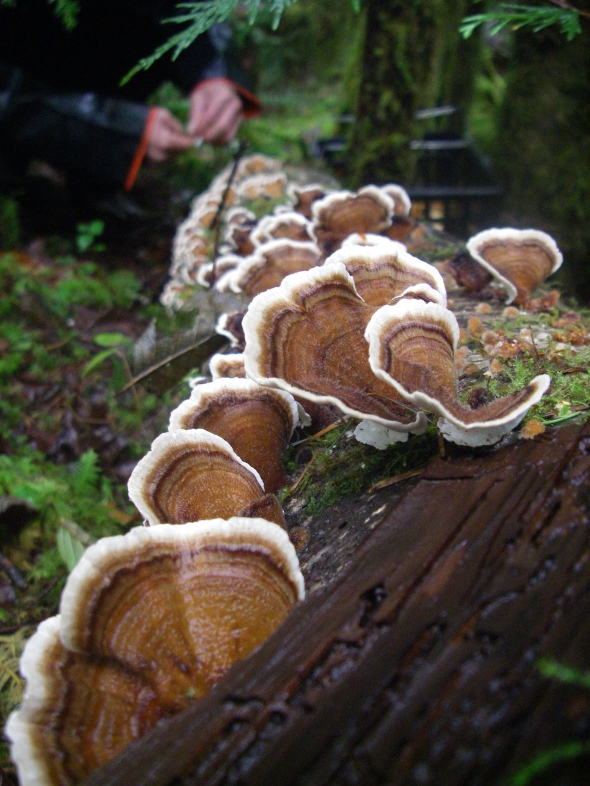
Turkey Tail (Trametes versicolor)!!!!
Look for a turkey tail in the most unlikely place …
Yes, this is the common name. I commonly find it growing on dead alder trees and I simply pull it or cut it off. I dry it and store it in jars. I grind it into a powder in a cuisinart blender and use it for tea. Nice mild mushroom flavour .Therapeutic effects: anti-bacterial, anti-oxidant, anti-tumor,anti-viral, immune enhancer, kidney tonic (Staments, 2002). Reference: Staments,P. 2002. MycoMedicinals, an informational treatise on mushrooms, MycoMedia Productions.Olympia,Wa.
Have fun on your own trek searching for mushrooms…..
When you open your eyes and take away the blinders a whole new world awaits. Enjoy the outdoors….
A Mountain, a Berry bucket, and a Bear

Blueberry Bucket
A day in the life of huckleberry and blueberry picking.
When do you know you have enough berries for the winter and when can you put away the berry bucket and stop clambering around like a bear up in the mountains?…. Lucid dreams of huckleberries and blueberries will tell you.
Purple haze sunsets, blueberry monsoons and the ultimate foretelling dream: a sketchy black bear demanding scoops of blueberries funneled down its stretched wide mouth, are a few of my recollections, indicating a time to stop berry picking for the season. But to say “enough berries for the winter” is to leave a beautiful area behind. It is beautiful up here in the berry patch. This is one place when asked ‘where is home’, I would think of, but would say somewhere else.
We drove on a road winding west and north, over contour lines and into valleys and sometimes seemingly straight skyward giving you a feeling that no map could offer. As elevation grew so did the scrubby bushes of red huckleberries and then the big patches of blueberries and black huckleberries. Around a bend a mother bear and two cubs scurry into obscurity. Further on another mother bear and two cubs scurry into obscurity. The air is a little crisper up here. The backdrop for the berry patch: a mountain clinging to the heavens and so magnificent that you hope you absorb something it has, from just awing it.
The mornings are cool and have a slow start, but not because of the chill in the air. The imperceptible slowness of the morning: drinking tea, eating breakfast, another tea and so forth is all to blame on the scenery. The shifting angle of the sun on the rock above reveals a different face from a moment before. Illuminating light turns the rock pillar orange then descends into the valley changing the shadowed dull conifers a glowing green, all the while awakening another day and another day berry picking.
I follow a bear trail. They always seem to know the easiest route through the scrubby growth of berry bushes, but today, to say it is a bear trail is a long fetch of the imagination. Yes, the ground is visibly worn but only visible when the berry branches are parted, and to neatly part a woven fence of branches sometimes needs the weight of a bear or a bear family. I clamber onto a fallen tree but don’t gain any quicker distance to the berry patch up the hill. It is a vertical crawl along a length of downed fir trunk on a vertical slope. I look down into a sea of unknown depth and footings, always ready for a shift in movement in this precarious vertical world of logs and branches and hillsides. Finally, a mossy plateau and a place the bushes are dripping with berries, a place untouched by the paws and jaws of a black bear.
It is a productive day in the berry patch but it has taken as much scouting around as picking to find spots the bears have not reached. Left overs is what I get and left overs is maybe how it should be. Being a forager, being in the fresh air and in the wilds turns one a little wild, a little feral and I feel almost like a bear and I want the berries too. It’s less a competition than a work of sharing. They leave me more than enough berries. They not only show me ways through the scrub, moreover their expanded awareness of the environment has a way of helping me get through it safely. I come across numerous clawed out holes dug into logs, dug into humus, diggings through tunnels to devour hornet nests deep in the moistness of the earth. The vestige of the hornet nest looks like shredded grey recycled paper with a few hapless hornets clinging on. I’m thankful to the bears. I’d funnel my whole winter supply of berries to that lucky bear in my blueberry dream if it can just get me through the berry patch without stepping on one of those land mines!
Good luck berry harvesting for the season !
Here’s some photos of a day in the life of a berry picker for my winter supply.

Blueberries

Black Huckleberries and Blueberries
On the left is Black Huckleberries, much less acidic tasting than the Blueberries on right. Black Huckleberry bushes were less prolific than the blueberry bushes and I found the berries tastier.

Red Huckleberries
High Up the Slope!
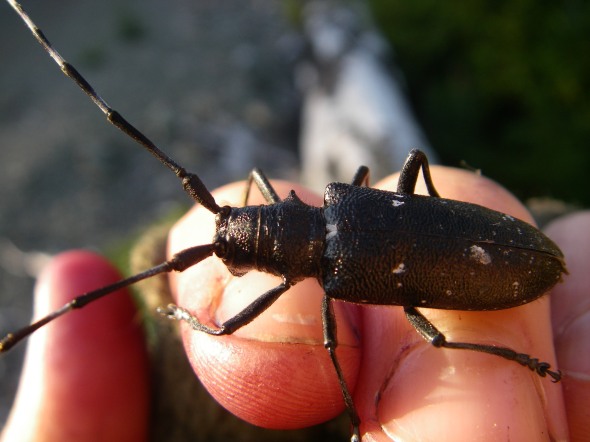
A White spotted Sawyer Beetle
A visitor for a few minutes….. a white spotted Sawyer Beetle native to the forests of British Columbia. A similar looking invasive species the Asian long horned beetle is from China and is a danger to the forests here.
 Berry hands after a day of picking.
Berry hands after a day of picking.

Berry Patch
A woven wall of blueberry bushes!

A natural bridge to the berries
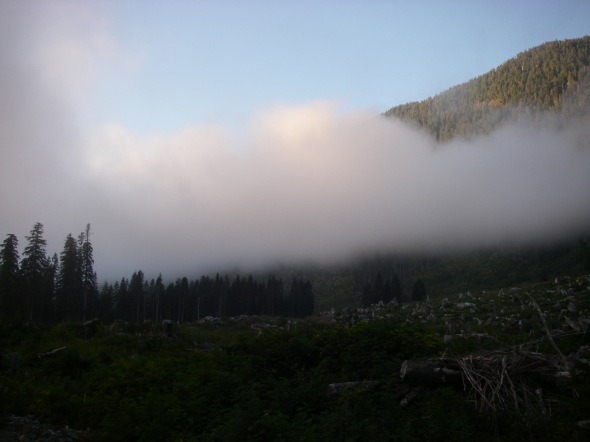
The fog rolls in from the west coast after a day of picking
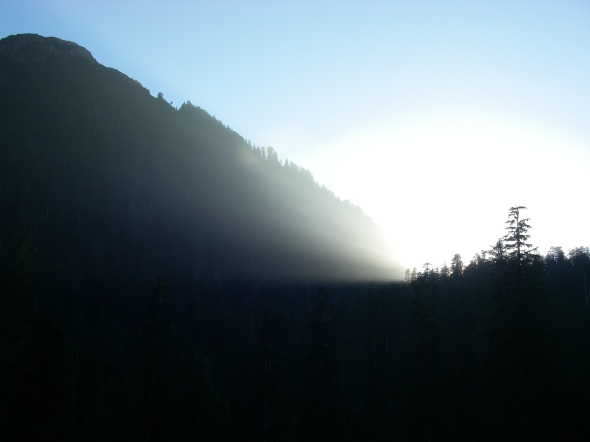
Sun over the Mountain
And after all the picking….. time to put them in the freezer.
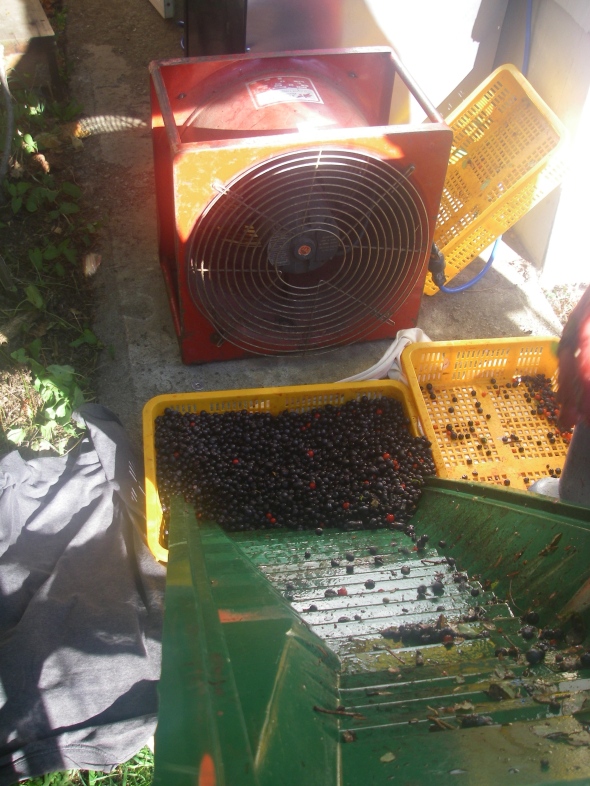
Blowing away the leaves
A plastic sluice box and a big fan is the trick to blowing away the collected debris in the berry pail.
Stalking the good life!

Set to go!
In his book “Stalking the good life, my love affair with nature”, author Euell Gibbons (1971) expresses his passion for collecting wild edibles and being in the natural world. He continued to write more books prefaced with the word “stalking”, all having to do with searching for plants and wild places, in addition to educating children about nature. Unfortunately, perusing the printing dates it appears the book was not published beyond 1971.
Could this tell us something? Something like, maybe the popularity of the “good life” isn’t about getting outside and enjoying nature and fresh air now a days. Maybe with each generation the feeling of a day spent outdoors gets slowly eroded from the memory until the stream of thought carves a whole new path and like an old oxbow in a river becomes unrecognizable and forgotten. This brings me to a startling memory of a college student, who literally appeared having never seen the light of day, telling the sociology professor “there is no value in nature.” Why? The conclusion. It’s a waste of time, and money cannot be made walking through the woods.
The “good life” is different for every one. Some people strive for the mansion with granite and porcelain, the infinity pool overlooking the golf course, all neatly tied with bow and ribbon in a gated community with consumerism blowing out the open window. Other people find the “good life” in simpler ways. They venture outside into nature with their mansion neatly packed on their back or under a boat hatch- all 5lb. of it!
Everyone has different ideas of the “good life” but the fact is we only have one earth to enjoy it on. Our lives can get so consumed with things and with wanting, we get washed off our feet in a flood of consumerism and taken with the current fighting for a way out.
Lets just forget about this for a moment!!!
Here are some “good life” moments!!
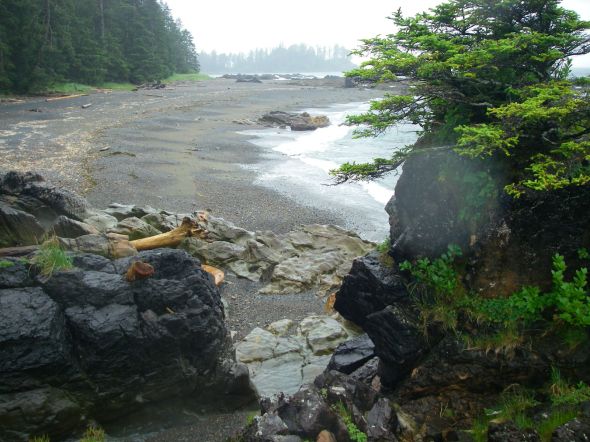
Somewhere on the coast!

Beachcombing!

stormy weather

The Past on the coast

dinner
Vancouver Island Cougars
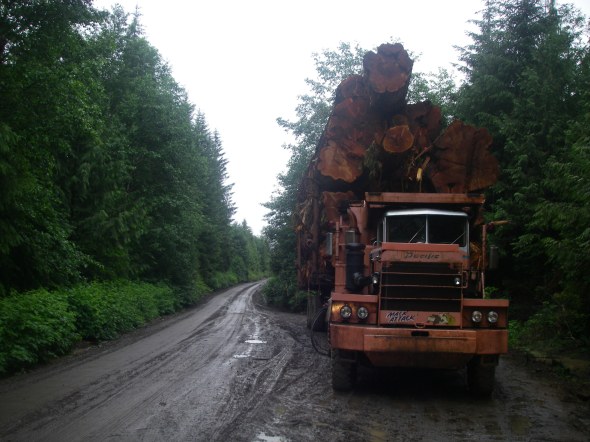
Vancouver Island Logging Road
I was hoping it wasn’t going to be a summer of encountering cougars when in late spring driving down a logging road as evening darkness approached, I saw one. The long stretch of tunnel road carved out by the width and height of logging trucks and now growing in from disuse gave a distant view of a brown shape in the distance. Immediately, I tried to logically think what it was. Deer, no wrong shape. Wolf, no didn’t seem right. Cougar, yes… Immediately I slowed my truck almost to a stop ( regarding truck: not the logging truck!! ) , glued my eyes to where the animal had moved into the bush and crawled the truck the next quarter mile. At the exact spot I turned the engine off, looked over a two foot embankment into scrubby stream foliage and instantly locked eyes with a cougar ten feet away.
It’s unnerving looking into the eyes of a cougar. It is a straight penetrating stare with
no glance away. It can last for minutes. It’s unnerving because you must do the same, look into those huge round eyes in that huge round head and ….wait (especially important if you meet without the security of your vehicle!). After a few minutes the tawny brown cougar slinked away, like an oversized housecat. My neighbor cats who I’m not on friendly terms eye me the same way. They love my garden to hunt and disturb and sometimes spray and just like a cougar they will hide high on the fence and study me. They give me the same reaction as when I see a cougar.
I’ve had other encounters with cougars. One approached me at ten feet and another time one was five feet away and hiding in thick foliage and hardly discernable. Because of this I never forget we are sharing the bush with cougars and if you haven’t had encounters it’s easy to forget they exist. I like to think the weather effects them and their prey, my theory. But I’m not an expert or authority on cougars. In turn, weather may effect movement of limited prey making cougars travel and compete in another cougars territory making them physically and mentally weak and altering their behaviour. Or maybe simply severe hot or dry periods could be a stressor. Scientific studies state that cougars may become more aggressive due to low prey count/habitat, limited competition for territory or aggressive genetics. Be aware when hiking and glance around a lot.
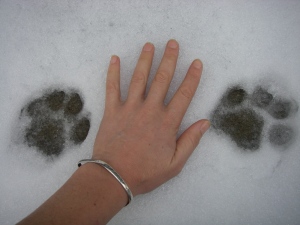
small cougar print
Do not have your eyes glued to the ground.
If you encounter a cougar, stop immediately and completely face your body towards it and look directly in the eyes …don’t turn to run….because running is not an option and diverting your eyes is an invitation for opportunity. Yell at it… don’t retreat until it has, and even then throwing objects in its direction is a good idea.But don’t stop yelling. You want it gone for good.
It always frustrates me to see people with their young children out in the bush with not a worry about the inevitable if you’re out there enough. Childrens’ voices sound like a deer to a cougar. Recently, I saw the perfect scenario for a cougar attack on a young child and fortunately all that was missing was the cougar. I watched in disbelief as a little child 4-5 years was left on its own to play by the river in a remote area while the parents were not even within its sight. I was sure that the high- pitched yelling to the parents would have attracted a cougar. The fact is little kids are cougar attractors and I don’t even think most dogs are tuned into sensing cougars.
When I hike I have a bear banger around my neck and bear spray and a knife. Even when I am out in the bush and pop out of the vehicle for a break I always make sure the bear banger is around my neck.
With all this talk perhaps you’ll never see one in your life. But they are real and alive
and out there and it is unreal and a reminder when you do see one.
Fortunately it hasn’t been a summer of unnerving cougar encounters. So far just an an encounter with a mean looking mother grouse in addition to numerous wolf pack encounters.
A warm day on the coast
At the end of May the hillside of swaying wild rye and Nootka rose overlooking a west coast beach is resonating with pounding surf and prolific with blooms of wild strawberry.
wild strawberry.
A month and a half later climbing up the gentle slope I sink knee deep in strawberry plants that have tangled themselves into a jungle that naturally shelter the berries from the southwest and northerly winds. I reach down and spread the plants apart finding ripe red gems that actually are quite large( 1.5 cm approx.), and similar in size as the polished pebbles on the beach below.
In no time, I’m filled up, my hands are stained and I savor not only the food I have come to find here but also this incredible day and place I have come to know.
It’s an incredible day because a strong northerly wind has plowed away the clouds 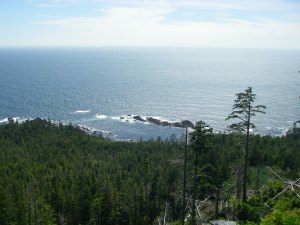 and thrown diamonds into the sea. The sun and wind have enlivened the whole landscape by pushing away the monochromatic gray that can frequent this place for days on end and replacing it with vivid greens, movement of shadows, and sounds to accompany the ravens conversation. The changing angle of the sun blurs the distinction between imaginary and real; a black shadow one minute resembles a bear, and another minute the realization it is a large piece of driftwood peeking out from the fringe of salal. The cedar spires and the wind shaped spruce bordering the bay stand like powerful sentinels, survivors of the freight train winds that funnel up the valley beyond and the gatekeepers who overlook the infrequent human visitor.
and thrown diamonds into the sea. The sun and wind have enlivened the whole landscape by pushing away the monochromatic gray that can frequent this place for days on end and replacing it with vivid greens, movement of shadows, and sounds to accompany the ravens conversation. The changing angle of the sun blurs the distinction between imaginary and real; a black shadow one minute resembles a bear, and another minute the realization it is a large piece of driftwood peeking out from the fringe of salal. The cedar spires and the wind shaped spruce bordering the bay stand like powerful sentinels, survivors of the freight train winds that funnel up the valley beyond and the gatekeepers who overlook the infrequent human visitor.
By late afternoon the softening light will have turned this place into what it really is….gold, a precious place for the wolves and bears that frequent it.
Note: The Wild Strawberry has a shorter and narrower terminal tooth than the rest of the teeth on its leaflet and long stalks distinguishing it from the woodland and coastal strawberry.
December chanterelles on the coast
Christmas day….. hiking among the towering sitka spruce and following wolf trails up embankments beyond the fringe of salal above the storm washed beaches of the west coast of vancouver island….a spruce branch filtered sun ray illuminates a patch of chanterelles. This is the latest in the season I have found them. Inland I have found them in late november preserved and solid frozen but never fresh like these. And what a scenic location for the chanterelles to grow…Remote, a place for the wolves to have their space and the land to hear no humans. Luckily a few places still remain like this.
Cantharellus ciborium grow in many areas on the island and sometimes what looks like prime mushroom growing habitat does not have one mushroom! Or perhaps it’s only the wrong day or week which again means nothing because air temperature and moisture seem to dictate them popping up. In mid to late August I like to keep aware of the first decline in night temperature and the first rains after a dry summer……and then start monitoring different spots. The prices never seem to warrant selling them….a good winter supply is more rewarding. In the past I partially open air dried them, then sliced them and put them in the freezer. This does work and makes a fine addition to soups or pretty much anything. But the preferred method is to slice them, put them on racks in a dehydrator and dry them completely, then store in sealed glass jars. I feel they retain more flavour, colour and texture this way.
Hope you enjoy eating some yourself or just enjoy discovering them on your walk.
SALMON and CHANTERELLE dinner
DISH 1- lightly saute 2 onions, 2cps sliced chanterelles,4 tbls olive oil DISH 2- Cube 1/4 fillet sockeye salmon mix with 6 tbls olive oil dust with 1/4 flour sprinkle with cayenne and herbs of choice ****** Put cubed salmon over the sautéed ingredients Cover with 5 cps chopped KAle COOK for 10-15 min@ 350 Top with fresh chive and parsley -SERVE with vegs/potatoes SERVES 2




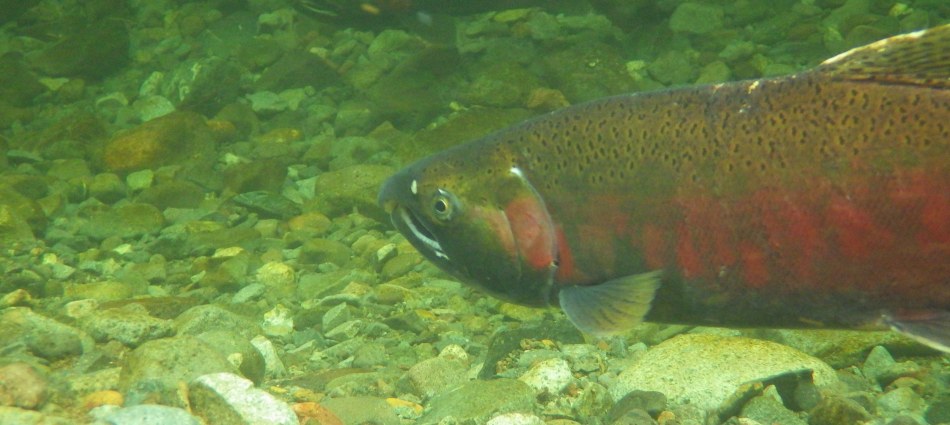





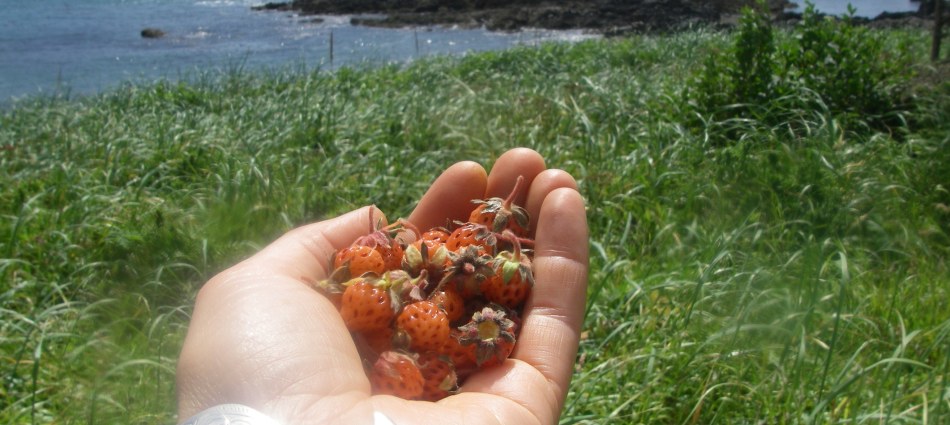






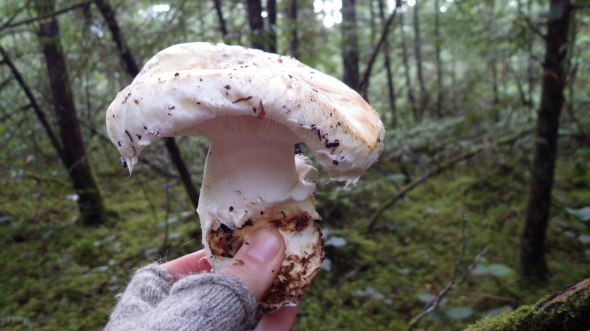
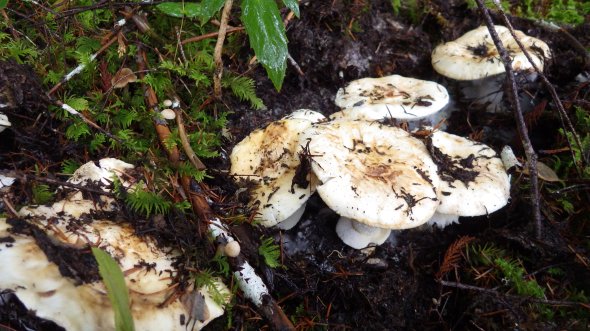
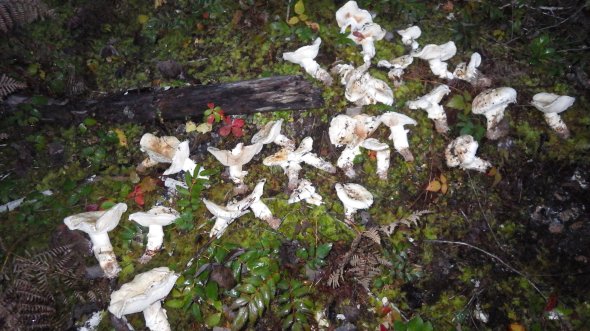 Its difficult to forget about mushrooms ………when the right habitat presents itself ……… curiosity leads to discovery and an unexpected find…..purposely arranged, I had to return with a basket.
Its difficult to forget about mushrooms ………when the right habitat presents itself ……… curiosity leads to discovery and an unexpected find…..purposely arranged, I had to return with a basket.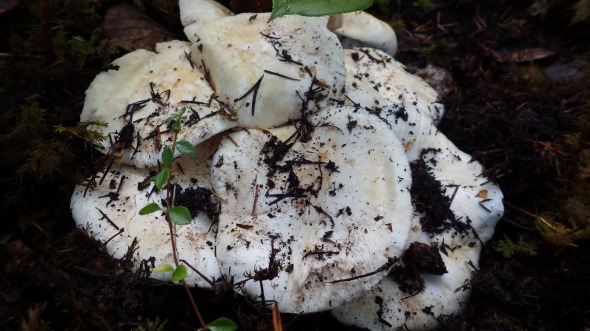
 And yes…you know it….sharing the bush with others. A nice fresh cougar track…big cougar track.
And yes…you know it….sharing the bush with others. A nice fresh cougar track…big cougar track.

 Pine mushrooms sliced a 1/8 inch and dehydrated for approx. 12 hours at 125 F
Pine mushrooms sliced a 1/8 inch and dehydrated for approx. 12 hours at 125 F
